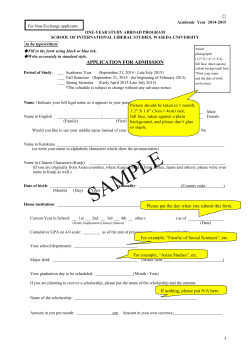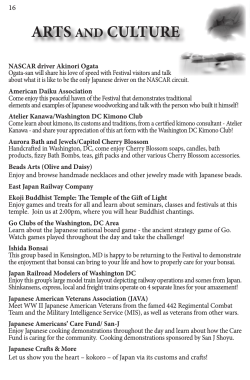
Japanese Beginners – Sample assessment tasks Reading
Japanese Beginners – Sample assessment tasks Reading Language: Japanese Target group: Year 12 Marks: 10 Weighting: 10% Date: Term 3 Year 12 Syllabus topic: Friends, recreation and pastimes Component: Reading 10% Context Students have completed the topic of Friends, recreation and pastimes are now revising this topic including more advanced structures. Task • Read the emails from Kenji and Keiko about their weekends and answer in English the questions that follow. Outcomes to be assessed A student: 2.1 understands and interprets information in texts using a range of strategies 2.2 conveys the gist of and identifies specific information in texts 2.3 summarises the main points of a text 2.4 draws conclusions from or justifies an opinion about a text 2.5 identifies the purpose, context and audience of a text 2.6 identifies and explains aspects of the cultures of Japanese-speaking communities in texts Marking criteria Students will be assessed on their ability to: • understand and interpret the gist and specific information from a text • draw and justify conclusions with supporting evidence from a text • justify an opinion about a text Marking guidelines are attached to the task. Feedback • Teacher will provide oral and written feedback on the task. © State of New South Wales through the NSW Department of Education and Training 2008 http://www.curriculumsupport.education.nsw.gov.au/index.htm 1 Japanese Beginners – Sample assessment tasks Reading Read the following emails and answer the questions in English. Email 1 けい子さん、元気? ぼくは、土よう日のよる、ぼくの大好きなロックバンドのコンサートに行っ た。行く時、電車がすごくこんでいて、たいへんだった。コンサートは、と そと ってもよかったよ。でも、このコンサートは外であったから8時ごろあめが ふって、さむかった。それで、今かぜをひいている。それに、ごみがいっぱ いあって、トイレもきたなかった。けい子さんの週まつは、どうだった? けんじ Email 2 けんじくん、私は、元気よ。 今、家でホームステイしている、りゅう学生のトムくんが、日よう日にカラ オケに行ってみたいと言ったから、はらじゅくえきの前にあるカラオケボッ クスに行った。そのカラオケボックスは、えい語のうたがたくさんあって、 食べ物もやすくておいしかった。トムくんは、うたが大好きで、たくさんう たったけど、じつは、トムくんのうたは、すご~くへたなの。私は、トムく んのへたなうたを 3 時間ぐらい聞かなければならなかったから、ちょっとた いへんだった。でも、トムくんはとてもうれしそうだったからよかった。 けい子 Questions 1. Who is Tom? (1) 2. Where is the Karaoke Box located? (1) 3. Do you think Tom had a good time on Sunday? Why/why not? (3) 4. How were the writers’ weekends overall? (5) © State of New South Wales through the NSW Department of Education and Training 2008 http://www.curriculumsupport.education.nsw.gov.au/index.htm 2 Japanese Beginners – Sample assessment tasks Marking guidelines and sample answers Question 1 Outcomes assessed: 2.1, 2.2, 2.5 • Identifies who Tom is 1 Sample answer: Tom is an overseas student who is staying at Keiko’s house. Question 2 Outcomes assessed: 2.1, 2.2, 2.5 • Identifies the location of the Karaoke Box 1 Sample answer: It is located in front of Harajuku station. Question 3 Outcomes assessed: 2.1, 2.2, 2.3, 2.4, 2.5, 2.6 • Demonstrates comprehensive understanding of how Tom felt • Supports the answer with appropriate references to the text • Demonstrates good understanding of how Tom felt • Supports the answer with references to the text • Identifies some relevant information 3 2 1 Sample answer: Yes, I think Tom had a very good time on Sunday because he wanted try Karaoke and he loves singing so Keiko took him to a karaoke box. The Karaoke Box had a lot of English songs and delicious food and Tom sang for 3 hours so it is likely that he had a good time. Question 4 Outcomes assessed: 2.1, 2.2, 2.3, 2.4, 2.5, 2.6 • Demonstrates comprehensive understanding of the texts • Supports the answer with appropriate references to both texts • Demonstrates good understanding of the texts • Supports the answer with some references to the text/s • Demonstrates some understanding of the texts • Provides isolated information 4-5 3 2 1 © State of New South Wales through the NSW Department of Education and Training 2008 http://www.curriculumsupport.education.nsw.gov.au/index.htm 3 Japanese Beginners – Sample assessment tasks Sample answer: While Kenji enjoyed the concert, he probably did not enjoy his weekend overall as much as Keiko. He says it was terrible getting to the concert and as it was outside and it rained, it was cold. Furthermore, he was not very impressed with the venue and its facilities. On the other hand, Keiko appears to have had a better weekend than Kenji. The Karaoke Box she took Tom to had lots of English songs and they enjoyed the food. Although Keiko had to endure Tom’s terrible singing, she says she was happy because Tom looked very happy. Therefore Keiko’s weekend was, overall, successful. © State of New South Wales through the NSW Department of Education and Training 2008 http://www.curriculumsupport.education.nsw.gov.au/index.htm 4 Japanese Beginners – Sample assessment tasks Writing in Japanese Language: Japanese Beginners Target group: Year 12 Marks: 20 Weighting: 20% Date: Term 3 Year 12 Syllabus topics: Friends, recreation and pastimes; People places and communities; Education and work Component(s): Writing 20% Context Students have completed the above topics and are now revising these topics including more advanced structures. Tasks • In Writing Part A Question 1, students are to respond to an email recommending a good restaurant for visitors from Japan. The email is to be written in Japanese and approximately 100 ji. • In Writing Part A Question 2, students are to read the information given about an apartment and write an email of approximately 150 ji in Japanese to their Japanese friend. • In Writing Part B, students choose either Question 3 or Question 4, and write an extended response of approximately 250 ji in Japanese. Outcomes to be assessed A student: 1.1 establishes and maintains communication in Japanese 1.2 manipulates linguistic structures to express ideas effectively in Japanese 1.3 sequences ideas and information 1.4 applies knowledge of the culture of Japanese-speaking communities to interact appropriately 3.1 produces texts appropriate to audience, purpose and context 3.2 structures and sequences ideas and information 3.3 applies knowledge of diverse linguistic structures to convey information and express original ideas in Japanese Marking criteria Students will be assessed on their ability to: • understand, draw conclusions and interpret the gist and specific information from a text • apply a range of vocabulary and linguistic structures within the contexts • manipulate linguistic structures to express ideas effectively in Japanese • structure information and ideas coherently • produce a text for a specific audience, purpose and context Feedback • Teacher will provide oral and written feedback on the task. Written feedback will be in the form of annotations on the task. © State of New South Wales through the NSW Department of Education and Training 2008 http://www.curriculumsupport.education.nsw.gov.au/index.htm 5 Japanese Beginners – Sample assessment tasks Writing Part A Question 1 (4 marks) A Japanese exchange student who is at your school has sent you an email asking for advice on a good restaurant nearby as his parents are coming from Japan. Write an email in response. Write approximately 100ji in Japanese. Sample answer Text type is made clear by having an addressee (although this is not necessary in an email). Good use of kanji for name - kanji that may otherwise not be used. Good descriptive language using combination of adjectives. 友子さんへ、 Shows knowledge of the conventions of the writing system by using katakana for borrowed words. 学校のちかくにやすくて、おいしいスペインりょうりのレストランがありま す。毎週、金よう日にはフラメンコのダンスのショーがあります。ごはんを 食べながら、ショーを見ることができます。行ってみてください。 キムより Good use of prescribed prescribed kanji throughout the composition. Signing off with own name is consistent with email text type. Use of particular syllabus structures (shaded) to achieve a specific purpose. General comment Response is of a good length satisfying the 100 ji length requirement and uses conventions for the email text type. Student has been thorough in the use of prescribed syllabus kanji and accurate spelling of katakana words. A variety of syllabus structures has been used which makes the writing interesting and shows the student’s competency in the use of prescribed grammar. The response is structured in a coherent and appropriate way for this task and the question has been answered well. © State of New South Wales through the NSW Department of Education and Training 2008 http://www.curriculumsupport.education.nsw.gov.au/index.htm 6 Japanese Beginners – Sample assessment tasks Writing Part A Question 2 (6 marks) You have finished your HSC and are living in Japan and attending Waseda University. You have found a new apartment. See the real estate advertisement for it below. Write an email to your Japanese friend about your new apartment. Write approximately 150ji in Japanese. シャワー トイレ キッチン まど さつきアパート わ せ だ 早稲田大学のちかく えき おしいれ まど わしつ 駅 バスてい 買い物 おふろ 一ヶ月 五分 三分 べんり なし 五万七千円 © State of New South Wales through the NSW Department of Education and Training 2008 http://www.curriculumsupport.education.nsw.gov.au/index.htm 7 Japanese Beginners – Sample assessment tasks Sample answer Good use of prescribed kanji for name Good introduction of topic of email i.e. writing about new apartment. 海くんへ、 Demonstrates understanding of the information given in the stimulus text by incorporating into response. 元気ですか。あたらしいアパートをみつけました。おふろがないけど、あか るくていいへやです。キッチンにまどがあって、こうえんが見えます。だか Correct use of particle ら、そとを見ながらごはんをつくることができます。大学や、アルバイトに ちかいから、べんりです。来週の土曜日にひっこすつもりです。 こんどあそびに来てください。 ジェーンより Applies knowledge of syllabus structures (shaded) to create a complex structure e.g. two syllabus structures bi d Effective and informative text incorporating own ideas showing creativity General comment Student has responded in the required text type (email). The use of ~へ and ~より are not required in an email but their use has made the text type explicit; i.e. a letter or an email (in this case an email). The student has shown understanding of the conventions of the Japanese writing system by using a variety of appropriate scripts. A number of syllabus structures has been used accurately indicating a thorough knowledge and understanding of prescribed syllabus grammar. The student has also shown consistent use of prescribed kanji. In addition, the student has responded to selected information presented in the stimulus text. It is important to note, that where there is stimulus text given in the question, students must show they have understood the information presented by incorporating selected parts in their response. The student had also shown creativity by presenting original ideas that are appropriate. © State of New South Wales through the NSW Department of Education and Training 2008 http://www.curriculumsupport.education.nsw.gov.au/index.htm 8 Japanese Beginners – Sample assessment tasks Writing Part B (10 marks) Question 3 あなたは去年、一年間日本にりゅう学していました。今年12年生としての せいかつについて、ホストのお母さんにてがみをかいてください。 You spent last year as an exchange student in Japan. Write a letter to your host mother about your life as a Year 12 student this year. Write approximately 250ji in Japanese. OR Question 4 あなたはあたらしいアルバイトをはじめました。はじめての日について、 日本人の友だちに、てがみをかいてください。 You have just started a new part-time job at a Japanese restaurant. Write a letter to your Japanese friend about your first day. Write approximately 250ji in Japanese. © State of New South Wales through the NSW Department of Education and Training 2008 http://www.curriculumsupport.education.nsw.gov.au/index.htm 9 Japanese Beginners – Sample assessment tasks Writing Part B (10 marks) Question 3 あなたは去年、一年間日本にりゅう学していました。今年12年生としての せいかつについて、ホストのお母さんにてがみをかいてください。 You spent last year as an exchange student in Japan. Write a letter to your host mother about your life as a Year 12 student this year. Write approximately 250ji in Japanese. Sample answers Starting off by writing the addressee shows that it is a letter お母さんへ お元気ですか。私は元気です。先週、学校がはじまりました。 今年は、12年生です。10月にしけんがあるから、がんばるつもりです。 学校では、えい語、すうがく、おんがく、かがくと日本語をべんきょうして います。日本語が一ばんやさしいです。かがくは、むずかしいから好きじゃ ないです。毎日たくさんのしゅくだいをしなければなりません。週まつは、 アルバイトをしたり、べんきょうしたりします。 しけんがおわったあとで、日本に行きたいと思います。お母さんは、どう思 いますか。じゃ、きょうは、これで。お父さんと、ゆうじくんによろしく。 Good content. Student uses a variety of syllabus structures (shaded) as well as using all prescribed Very authentic closing statement ジェシーより 二月十五日 Writing the date at the end shows that it is a letter rather than an email. © State of New South Wales through the NSW Department of Education and Training 2008 http://www.curriculumsupport.education.nsw.gov.au/index.htm 10 Japanese Beginners – Sample assessment tasks Writing Part B (10 marks) Question 4 あなたはあたらしいアルバイトをはじめました。はじめての日について、 日本人の友だちに、てがみをかいてください。 You have just started a new part-time job at a Japanese restaurant. Write a letter to your Japanese friend about your first day. Write approximately 250ji in Japanese. Sample answer ~さんへ clearly shows the text type being used, i.e. a letter けんさんへ、 Excellent use of prescribed kanji and variety of syllabus structures (shaded) こんにちは!お元気ですか。私は元気です。今日、日本りょうりのレストラ ンでアルバイトをはじめました。ノースシドニーのえきのちかくにあって、 名前は、さくらといいます。とてもたのしかったけど、いそがしかったです。 私はウエイトレスのしごとをしたり、おみせのそうじをしたりしました。日 本人のおきゃくさんと、日本語で、すこし話すことができました。しごとが おわったあとで、おいしい日本のおちゃをのんでもいいんです。ラッキー! 毎週土よう日にアルバイトをするつもりです。また、てがみをかきます。 Long sentence with two syllabus structures, i.e. a complex sentence ~より and the date at the end is the standard way of finishing off a letter カイリーより 2月7日 General comment Both responses are of good length, approximately 250ji. Both have followed conventions for the text type required, a letter. In a letter, there are usually opening and closing statements as well as a date at the end. Opening statements such as お元気ですか is customary. A variety of appropriate vocabulary and syllabus structures has been used throughout the compositions. Consistency has been shown in the use of prescribed kanji. Students have organised their ideas and presented the information in a logical and coherent manner that is easy to read. © State of New South Wales through the NSW Department of Education and Training 2008 http://www.curriculumsupport.education.nsw.gov.au/index.htm 11 Japanese Beginners – Sample assessment tasks Writing in Japanese Part A (4 marks) Question 1 Outcomes assessed: 1.1, 1.2, 1.3, 1.4, 3.1, 3.2, 3.3 Marking guidelines • • • • • • • Criteria Communicates ideas and information appropriate to audience, purpose and context Applies knowledge of vocabulary, language structures and features to the task Demonstrates good control of the conventions of the Japanese writing system Communicates with some awareness of audience, purpose and context Demonstrates some knowledge of vocabulary, language structures and features Demonstrates some control of the conventions of the Japanese writing system Produces some comprehensible language related to the task Marks 4 2-3 1 © State of New South Wales through the NSW Department of Education and Training 2008 http://www.curriculumsupport.education.nsw.gov.au/index.htm 12 Japanese Beginners – Sample assessment tasks Writing in Japanese Part A (6 marks) Question 2 Outcomes assessed: 1.1, 1.2, 1.3, 1.4, 3.1, 3.2, 3.3 Marking guidelines • • • • • • • • • • • • • Criteria Communicates relevant ideas and information appropriate to audience, purpose and context Organises information and ideas coherently Applies knowledge of a variety of vocabulary, language structures and features to the task Demonstrates excellent control of the conventions of the Japanese writing system Communicates with some awareness of audience, purpose and context Organises ideas and information Demonstrates knowledge of vocabulary, language structures and features Demonstrates good control of the conventions of the Japanese writing system Demonstrates some understanding of the requirements of the task Demonstrates limited evidence of the ability to organise ideas Demonstrates some knowledge of vocabulary, language structures and features Demonstrates some control of the conventions of the Japanese writing system Produces some comprehensible language related to the task Marks 6 4-5 2-3 1 © State of New South Wales through the NSW Department of Education and Training 2008 http://www.curriculumsupport.education.nsw.gov.au/index.htm 13 Japanese Beginners – Sample assessment tasks Writing in Japanese Part B (10 marks) Questions 3/4 Outcomes assessed: 1.1, 1.2, 1.3, 1.4, 3.1, 3.2, 3.3 Marking guidelines • • • • • • • • • • • • • • • • Criteria Presents and develops original ideas and information and/or opinions relevant to context, purpose and audience Organises information and ideas coherently Demonstrates knowledge of a variety of vocabulary, language structures and features Demonstrates excellent control of the conventions of the Japanese writing system Presents and develops original ideas, information, and/or opinions mostly relevant to context, purpose and audience Organises information and ideas Demonstrates some knowledge of a variety of vocabulary, language structures and features Demonstrates good control of the conventions of the Japanese writing system Presents and develops some ideas, information, and/or opinions relevant to context, purpose and audience Organises information and ideas with some coherence Demonstrates some knowledge of vocabulary, language structures and features Demonstrates some control of the conventions of the Japanese writing system Presents some information relevant to the task Demonstrates elementary knowledge of vocabulary, languages structures and features Uses some kanji appropriately Produces some comprehensible language related to the task Marks 9-10 7-8 5-6 3-4 1-2 © State of New South Wales through the NSW Department of Education and Training 2008 http://www.curriculumsupport.education.nsw.gov.au/index.htm 14
© Copyright 2025









